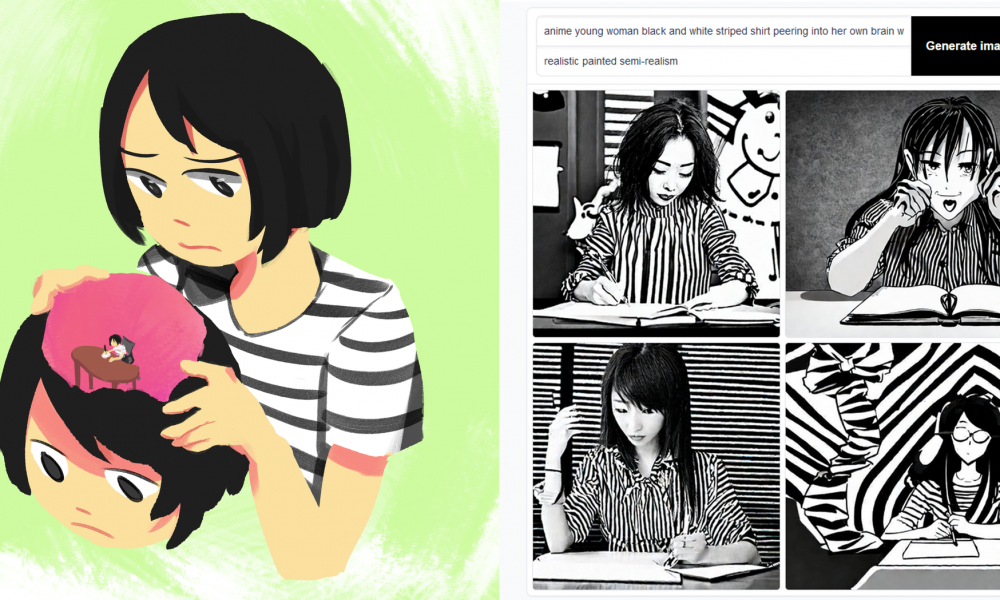For the past year, there have been dozens of conversations about artificial intelligence art online: how it will make art more accessible, the copyright issues and how it will affect professional artists jobs, for example.
Several AI art programs have gotten popular, such as Midjourney, which has recently updated to version 5. Another is DALL-E, a program whose parent company, OpenAI, has a $10 billion investment in 2023 by Microsoft. The program Stable Diffusion is valued at $1 billion by investors like Coatue and Lightspeed.
Let me first make this clear, AI “art” is not art.
I’m not saying this as an artistic criticism, I’m saying this because AI art doesn’t create anything. AI works by using a system called generative AI.
Generative AI has to train on a large dataset of images, text and software code, then it uses an algorithm trained on the dataset to transform this work into different images. It’s essentially a remix, but typically without the artists’ consent.
The image dataset that AI uses comes from scraping the internet for images, many of which are copyrighted or from popular artists who never consented to their work to be used for machine learning.
Nathan Lipsey, a senior computer science student at University of Nevada, Reno, stated that “AI doesn’t really have a sense of creativity. When AI produces art, all it’s doing is mimicking bits and pieces of the art that it’s been fed in the past.”
It can be argued that AI is merely a modern collage tool, a mix of thousands of images online to create something completely new, but it may make mistakes and only outwardly resembles the training data.
For example, sometimes AI makes simple mistakes that a human artist wouldn’t make, such as giving a hand six fingers or melting eyes off of a face. This is likely due to there being many source images where the hands are hidden or the eyes are stylized in a cartoon or anime art style.
“If you wanted a picture of a monkey in space, AI could certainly make that for you, but it’s just blending together stuff that it knows about,” Lipsey said. “A professional artist usually draws with intent. You might see the space logo on the monkey’s outfit be a banana-shaped planet or something like that, for example.
“An AI art program wouldn’t really think to do that unless a bunch of artists had been drawing monkeys in space with that specific logo.”
It would be interesting for me to see what AI could create from my art and I have had fun messing with AI using pictures I’ve taken from my phone.
The reason I will never use my own artwork as samples for AI is because it doesn’t feel authentic. None of it does. What is the point of being an artist if you remove the most important part of making art, the process?
It’s difficult to explain without being cheesy, but I simply find catharsis when I finish a difficult piece. I also enjoy drawing people in public and showing them the drawings, or absorbing myself fully in a world that I created.
The sad part about the art-making process is that it takes a long time and requires money, especially if it’s a huge project like an animated film or a video game.
Triple-A video games such as “Assassin’s Creed Valhalla,” “Cyberpunk 2077” and “Red Dead Redemption 2” had budgets that ranged from $80 million to $100 million and can take from five to eight years to create.
Animated films are well-known for having intensive workloads and huge budgets, from an average budget being $50 million and going up to $260 million. The other price of animation is that it also requires a specialized set of skills that necessitate years of training and occasionally entirely new software to create never-before-seen effects and animation.
This is where the real dilemma about AI art comes into play.
AI can create dozens of near professional level art pieces, such as concept art for animation and video games or editorial art for newspaper articles within minutes.
There are artists who have spent their entire lives building skills so they can eventually work in their dream jobs. There are also current professionals whose entire livelihoods are at stake if AI fully takes over.
However, there is hope.
Three artists including Sarah Andersen, Kelly McKernan and Karla Ortiz have started a lawsuit suing OpenAI, Stability AI and Midjourney for using their art and other artists’ works without permission in the AI’s datasets.
They intend to set legal precedent for AI art programs, stating that they want AI “to be fair and ethical for everyone.”
If this lawsuit is successful, it would mean that AI programs have to ask for explicit consent before training on any images. They would also have to remove all copyrighted images from their datasets or face more lawsuits in the future.
I understand that technology will always be advancing, but a human mind can never be implemented in a computer.
AI relies on stealing from not just big-name companies like Disney or Warner Brothers, but also smaller, independent artists that need art to survive.
Creativity is inherently a human trait, and a computer can never mimic the brain of an artist.




